IBM Internetworking
Available Languages
Contents
The Internetwork: A Strategic Asset
Companies and organizations increasingly rely on the rapid and efficient flow of information as a key strategic asset. They view their internetworks as the conduits of this information that enhance productivity and provide competitive advantages in the global marketplace.
Ultimately, it is the order of magnitude improvement in organizational productivity that is the compelling benefit of robust internetworks. Yet beneath this wide-ranging umbrella, MIS managers must focus on several issues that have tremendous influence on determining the effectiveness of their internetworks. Two of these issues—the availability of user applications and the total cost of ownership of a network—are inextricably linked to every company’s information systems strategy.
No company in the world can match Cisco Systems when it comes to maximizing the applications availability and minimizing the total cost of internetwork ownership. Over the last decade, our proven technology and complete range of scalable solutions have enabled us to set the pace in the networking industry. More than anything else, Cisco owes its leadership position to its unique and robust Cisco Internetwork Operating System (Cisco IOS®)—the value-added software that resides at the heart of all Cisco internetworking solutions.
Cisco IOS software is the key differentiator that separates Cisco’s internetworking solutions from other alternatives in the industry. For Systems Network Architecture (SNA) mission-critical application users, Cisco IOS software provides the industry’s most flexible migration paths to client/server and peer-to-peer applications of the future. Cisco IOS software’s value-added intelligence supports users and applications throughout the entire enterprise. It provides security and data integrity for the internetwork. It cost-effectively manages resources through the control and unification of complex, distributed network intelligence. Finally, it functions as a flexible vehicle to add new services, features, and applications to the internetwork.
Total Cost of Ownership and Applications Availability
Two critical issues drive the evolution of today’s information systems: total cost of ownership and applications availability. In IBM environments, companies can reduce their costs of ownership dramatically with the consolidation of multiple SNA and non-SNA networks into one multiprotocol internetwork. This consolidation eliminates redundant and expensive wide-area communications links and reduces personnel costs because it simplifies multiprotocol environments management. In addition, it provides an infrastructure that allows access to any application from any point in the network.
A consolidated internetwork must support common applications availability across any media or platform to ensure success. It must also provide high availability for mission-critical applications and predictable response time for end users. This requires a range of features that optimize link utilization, reroute around link failures, and prioritize mission-critical traffic.
Enterprise Networks Today 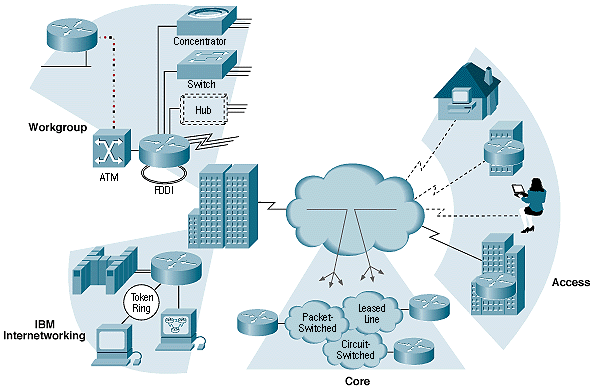
The enterprise of today and tomorrow has requirements that span all four internetworking sectors: Workgroup, IBM Internetworking, Core, and Access.
Challenges of SNA Integration
Many challenges confront network managers as they consider SNA integration. Perhaps most important is the need to cost-effectively consolidate SNA and LAN internetworks while SNA end-user response time and availability is still maintained.
Many enterprises also require a scalable solution that can handle networks of over 100,000 SNA devices. In addition, with the proliferation of new technologies in the local-area network (LAN) and wide-area network (WAN) arenas, the solution must offer flexible WAN and LAN choices to protect current and future investments. As enterprises become more dependent on their internetworks to be competitive, it becomes increasingly important that the internetwork be adaptable to new technologies. Finally, today’s multiprotocol internetworks require comprehensive network management tools that simplify management and allow centralized control, automation, and proactive resource planning.
High Availability
Mission-critical applications must be available twenty-four hours a day, seven days a week. To successfully integrate mission-critical traffic with LAN traffic, network administrators must be able to ensure applications availability. To do so requires a reliable transport mechanism that can reroute around failed links or load balance across multiple links.
High Performance, Predictable SNA Response Time
To ensure high performance, internetworks must fully utilize all available bandwidth and offer methods to handle periodic congestion. To fully utilize bandwidth requires high-powered platforms that can balance traffic across all available links and automatically dial backup links to handle peak traffic. As internetworks carry increased traffic, the likelihood of periodic traffic congestion increases. Techniques must be available that allow network designers to prioritize mission-critical traffic ahead of less important traffic, like electronic mail or noncritical file transfers. In addition, features that allow network designers to allocate bandwidth percentages to specific protocols will ensure that SNA users maintain predictable performance.
Scalability
An integrated multiprotocol solution must be scalable to connect arbitrarily large numbers of LANs or end stations. Features are required that can control source-route bridging (SRB) and NetBIOS broadcasts, to thereby avoid traffic flooding on Token Ring (TR) LANs. High-density, high-performance solutions can minimize space requirements, reduce costs, improve performance, and simplify network design.
Flexible Media Options
To protect current and planned investment and improve application access, internetworking platforms must offer flexible media support. Consolidation of Synchronous Data Link Control (SDLC) networks and LAN networks can greatly reduce costs while it protects customers’ investment in SDLC devices. In addition, end users need to access SNA applications regardless of how they are connected to the network, whether it is through SDLC, Token Ring, Ethernet, Fiber Distributed Data Interface (FDDI), or Asynchronous Transfer Mode (ATM).
Cost-Effective WAN Options
Because WAN costs are a recurring expense, flexibility in the choice of WAN options is critical. Multiple options—from dedicated links, to circuit-switched, to packet-switched—allow customers to select the service that provides the best performance and availability at the least cost.
Centralized, Automated Network Management
The final consideration is one of the most important. Comprehensive network management tools must allow network administrators to provide users with maximum network uptime and a high degree of applications availability. In addition, integrated management must simplify personnel training and administrative procedures. The ability to automate router installations and to centralize other router management activities means that skilled staff need not be present at each remote site.
SNA Integration Challenge 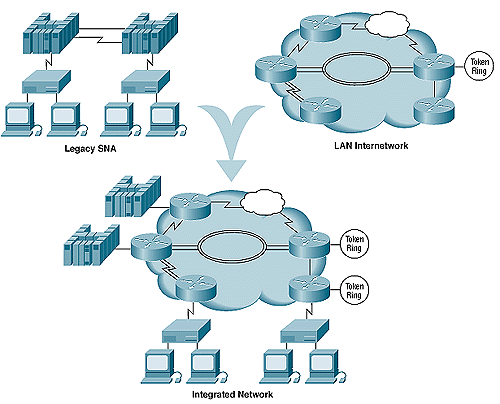
Cisco IOS software addresses the integration challenge with solutions that maximize availability, scalability, performance, flexibility, and management.
Cisco’s IBM Internetworking Strategy
Cisco is the industry leader in the integration of IBM SNA networks within the framework of today’s expanding multiprotocol global internetworks. In 1993, Cisco held over 67 percent of the SNA router market, according to an IDC study. Since initiating its five-phase SNA integration strategy in 1990, Cisco has introduced many industry firsts: the creation of the virtual ring concept, the first route caching mechanism, the highest-performing Token Ring card, and the first fully integrated SDLC conversion capability. The company is currently developing direct attachment to mainframe channels for TCP/IP and SNA.
Worldwide SNA Router Market 1993 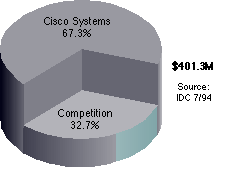
Cisco leads the SNA router market of over $400 million, which represents 23.5 percent of the overall router market in 1993.
IBM internetworking is unlike any other internetworking market segment. The challenges are unique, and the solutions are complex. To succeed in this market requires a serious commitment of resources and people. Cisco has made this commitment, building an infrastructure of dedicated resources with years of experience in IBM internetworking. As part of this infrastructure, Cisco offers IBM-specific network consultants to help you install your network.
Through its five-phase strategy for IBM integration, Cisco has delivered cost-effective, feature-rich, high-performance products. Cisco continues to enhance these offerings and is now delivering its fifth phase: full support of SNA peer-to-peer internetworking via Advance Peer-to-Peer Networking (APPN) Network Node (NN) technology, and the integration of mainframes and LAN internetworks via direct channel attachment.
Cisco IOS Software Extended Five-Phase IBM Integration Strategy| LAN | WAN | Management | Delivery | Extensions | |||
|---|---|---|---|---|---|---|---|
| Phase 1 | 4/16-Mbps SRB/RSRB | Private Packet-Switched | SNMP | 1990 | Enhanced VR, Scalability, Dynamic Spanning Tree | ||
| Phase 2 | IGS TR/Cisco 3000 | SDLC Transport | NetView–SNMP | 1991 | SDLC TWS, SDLC Broadcast | ||
| Phase 3 | TR–Ethernet | SDLLC Local Termination | LAN Network Manager | 1992 | QLLC Conversion, DLSw Standard | ||
| Phase 4 | IBM Chipset 4-Port TR | Cisco 4000 | SNA PU Type 4 Properties | 1993 | Custom Queuing, 270 kpps SRB | ||
| Phase 5 | Channel Attach | Cisco 7000 | APPN | SNMP v2 | 1994–1995 | TCP Offload, Channel APPN | |
Cisco’s IBM Internetworking Features: Meeting Business Needs
High Availability
Two key concerns of MIS managers are network availability and the maintenance of consistent end-user service levels. Cisco has developed several techniques that ensure a high level of reliability when SNA traffic is transmitted across a multiprotocol internetwork.
SNA, when transported across a Token Ring backbone, has two primary limitations: an inability to nondisruptively reroute around network failures, and a low tolerance for network delays. Both problems cause sessions to be dropped, which forces users to restart and subsequently lose valuable data and time.
Cisco overcomes the rerouting limitation through IP encapsulation. Through the encapsulation of the SNA traffic in IP packets, Cisco internetworking platforms can nondisruptively reroute SNA traffic around link failures. To avoid session loss, new routes must be found in less than 10 seconds. Cisco’s Enhanced Interior Gateway Routing Protocol (Enhanced IGRP) and Open Shortest Path First (OSPF) routing protocols can generally reroute around failed links in less than two seconds, making the link outage and recovery transparent to end users.
When SNA traffic shares links with other LAN traffic, link congestion can sometimes cause network delays. If round-trip delays exceed a few seconds, SNA devices will begin error recovery, and in some cases, SNA sessions will be dropped. In addition, SNA sends frequent control messages to ensure that session connections are active. These messages can waste expensive WAN bandwidth.
Cisco offers two features that help to overcome this limitation: IP routing and local acknowledgment. IP routing reroutes based on congestion or adapts to changes in traffic patterns. With local acknowledgment, Cisco products locally terminate link connections (both SDLC and LLC2), which prevents SNA session timeouts and minimizes control messages on the WAN.
Cisco’s Local Sessions Termination Feature 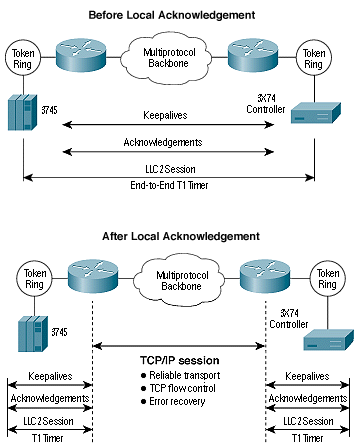
Cisco’s Local Session Termination feature enhances session availability and performance.
Scalability
Cisco internetworks offer tremendous scalability through several key features that provide support for very large Token Ring environments. With Cisco IOS software, several scalability limitations are removed, and you are allowed to do these thing:
-
Increase the number of Token Ring LANs that can be bridged together across an enterprise.
-
Increase the number of end systems that you can support without an increase in line speeds.
-
Attach more LANs to a single device and improve overall throughput within a building or campus.
Increased Connectivity
The source-route bridging protocol—commonly used to bridge Token Ring LANs—is not well suited to handle large Token Ring environments, because it limits the data path to less than seven bridges and eight rings. Many enterprises use one backbone LAN to connect one or more LANs on each floor of a building and another backbone LAN to connect multiple buildings on a campus. When one campus connects to another campus, it is quite easy to have LANs that cannot be bridged together because of the SRB limitation.
Cisco IOS software allows multiple internetworking platforms connected over arbitrary media to be configured as a single virtual ring, which removes the limitations of SRB and allows arbitrarily large Token Ring LANs. The virtual ring simplifies network topology and helps you to build large-scale networks, because it hides multiple hops. It provides intelligent path selection, because routing within the virtual ring can occur. And it reduces explorer traffic—which is used to find routes in a SRB network—because explorer frames within a virtual ring are not exponentially duplicated.
Virtual Ring Architecture 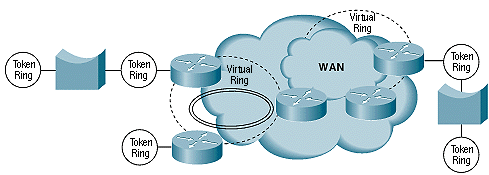
Cisco’s virtual ring architecture allows integration to scale to the largest, most complex networks.
Improved WAN Utilization
Cisco IOS software can significantly improve WAN utilization via the minimization of broadcast traffic on the WAN. Two key types of broadcast traffic are source-route explorer frames and NetBIOS Name Queries.
In an SRB network, end stations broadcast explorer packets to find session partners. Because each explorer packet is duplicated over each possible path, explorers can generate an inordinate amount of traffic in a large meshed Token Ring environment. To minimize these broadcasts, Cisco uses proxy explorers. With proxy explorers, when the Cisco IOS software learns the route to a given end system, it caches this information. Subsequent explorer frames to the same address are not broadcast across the bridged LAN. This can significantly reduce traffic in SNA networks, which saves expensive WAN resources.
Both the IBM LAN server and Microsoft LAN Manager operating systems use the NetBIOS protocol. When NetBIOS clients access servers, they first broadcast a name query across the entire bridged LAN. The query is sent several times to ensure that it reaches its destination, which creates a large amount of traffic that can consume lower-speed lines. To reduce this extra traffic, Cisco developed NetBIOS name caching. With name caching, only the first query is broadcast across a WAN, and the response is cached. Subsequent queries to the same name are not broadcast across the bridged LAN. Cisco also supports access lists, so a network administrator can control which servers can be accessed from a given location. This avoids any unnecessary waste of WAN resources, because all name queries for these resources are blocked at the Cisco router.
High-Density, High-Performance Token Ring Solution
In campus or building networks, Cisco offers a high-density Token Ring solution on its Cisco 7000 high-end platform. The Cisco 7000 supports up to twenty Token Rings via the use of Cisco’s four-port Token Ring card, which is based on the IBM “Spyglass” chipset and offers the highest-available Token Ring performance in an internetworking platform. Combined with silicon packet switching, the Cisco 7000 delivers a total aggregate throughput of over 270,000 packets per second (pps).
Predictable Response Time and Guaranteed Bandwidth Reservation
Legacy SNA generally has predictable, low bandwidth requirements, while client/server protocols tend to have bursty, higher bandwidth requirements. When legacy SNA traffic shares bandwidth with client/server protocols, it is critical that a technique be available to prioritize mission-critical traffic, which ensures that end-user response time is not impacted. Cisco has developed many features that ensure that high-priority messages are delivered quickly and reliably, regardless of congestion on a link.
Mission-Critical Traffic Prioritization
Without a priority mechanism, mission-critical traffic may get delayed behind large file transfers, which impacts customer service or delays important financial transactions. Network delays can sometimes be avoided with an increase in line speeds, but that is not always possible. To ensure that mission-critical traffic always takes precedence over less important network traffic, Cisco offers priority output queuing.
Priority output queuing enables network administrators to prioritize traffic, which provides the granularity that is required to ensure that mission-critical data can be isolated above all other traffic. Cisco offers four options by which traffic can be prioritized:
-
By protocol—This allows specified protocols to be prioritized ahead of all other traffic. For example, if SNA traffic is mission-critical, SNA messages can be given highest priority, followed by TCP/IP, then NetBIOS and other protocols.
-
By message size (small messages first)—This provides a simple means to prioritize interactive traffic ahead of batch file transfers.
-
By physical port—With the prioritization of an SDLC line ahead of a LAN or even the prioritization of one SDLC line ahead of another, network administrators can prioritize traffic from one department over another. For example, sales-related traffic flow can be prioritized ahead of administration traffic.
-
By SNA device—Prioritization by Logical Unit (LU) address allows specified devices (such as customer service terminals) to be prioritized ahead of others (for example, printers or administrative terminals).
Guaranteed Bandwidth Reservation
With Cisco’s custom queuing, network managers can guarantee that, during periods of congestion, mission-critical traffic receives a guaranteed minimum amount of bandwidth. If mission-critical traffic is not using its entire allotment of bandwidth, that bandwidth can be used by other traffic. For example, bandwidth could be reserved such that SNA traffic receives 40 percent of the bandwidth, TCP/IP traffic gets 25 percent, IPX gets 20 percent, and NetBIOS gets 15 percent, which ensures that SNA always has a large portion of the communication link available to it. If SNA traffic was light and only using 20 percent of the link, the remaining 20 percent allocated to SNA could be used by either TCP/IP or IPX traffic, which ensures maximum bandwidth utilization.
Custom queuing offers the same granular definition that is available with priority output queuing. Custom queuing is designed for environments that want to ensure a minimal level of service for all protocols.
Prioritization and Bandwidth Management 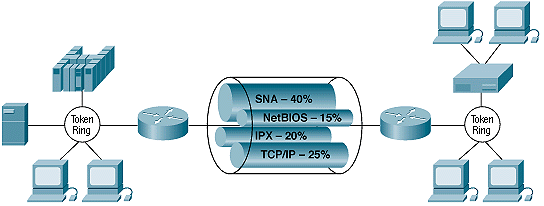
Cisco’s custom queueing capability provides predictable response times for mission-critical applications.
Media Flexibility: SDLC, LAN, and WAN
With Cisco’s wide selection of supported media and WAN services, network administrators can select media and services that offers the best price-to-performance ratio without concern for loss of connectivity. Cisco offers SDLC transport or conversion to LAN protocols, to protect customers’ investments in SDLC. Cisco supports key LAN media (Token Ring, Ethernet, and FDDI) as well as conversion between LAN protocols. Finally, Cisco offers support for a wide selection of WAN services and has led the industry in the support of emerging new technologies, including Switched Multi-megabit Data Service (SMDS), Frame Relay, ATM, and High-Speed Serial Interface (HSSI).
Investment Protection: SDLC Support
For companies that want to integrate SDLC environments with multiprotocol LANs, Cisco offers two options: convert SDLC to Token Ring or Ethernet, or transport SDLC without conversion.
Integrated SDLC Conversion
SDLC conversion can be used to convert remote SDLC-attached devices to Token Ring, which facilitates migration to a LAN environment. Through the use of this option, remote SDLC devices appear to a front-end processor (FEP) as Token Ring-attached, which enhances performance, simplifies configuration, and reduces line requirements on the FEP. In addition, smaller FEPs can be used to support SNA traffic.
In many SNA environments, Ethernet is becoming an increasingly popular option, due to the low cost of Ethernet adapters and the enhanced manageability with hubs. Presently, IBM 3745 FEPs do not support SNA over Ethernet. Cisco products allow remote Ethernet-attached devices to access mainframes via a 3745 FEP through the conversion of Ethernet to either SDLC or Token Ring.
Cisco platforms can also be used to convert traffic from remote SDLC-attached devices to Ethernet, which allows mainframe access via less costly 3172 establishment controllers.
SDLC Transport
Some environments need the ability to transport SDLC without conversion (for example, environments without Token Ring cards on their FEPs). Cisco’s SDLC transport allows network consolidation of multiprotocol LANs and SNA/SDLC environments without media conversion. SDLC transport can be used to carry FEP-to-FEP traffic in addition to FEP-to-controller traffic.
When SDLC transport is used to connect controllers to a FEP, Cisco offers an option called virtual multidrop, which makes multiple remote SDLC lines appear to the FEP as part of one virtual multidrop line. This option reduces costs, because it lowers the number of FEP lines required and simplifies configuration requirements for moves and changes.
Media Flexibility: LANs
Cisco offers high-performance transport of any protocol across Token Ring, Ethernet, and FDDI. With Cisco IOS software, SNA traffic can traverse any LAN media; for example, SNA can traverse FDDI or Ethernet backbone LANs. In addition, media conversion is possible between any pair of the supported LAN types.
Cost-Effective WAN Services
Because WAN services are a recurring cost, flexibility in the choice of WAN services is key. Cisco internetworking platforms allow users to select the service that provides the best performance and availability at the least cost. These include dedicated point-to-point links at speeds that range from 1.2 kbps to 155 Mbps; circuit-switched services for low call-volume applications; packet-switched services, including X.25, Frame Relay, and SMDS; and cell-switching services, such as ATM. Cisco’s Frame Relay support allows separate virtual circuits for SNA and non-SNA traffic, which provides a means to ensure the service level of SNA while SNA is consolidated on a single physical link with other protocols.
With dedicated circuits, the network allocates a fixed amount of bandwidth to exclusively serve the two end points on a given link. Circuit-switched services, on the other hand, offer advantages in low call-volume applications because they provide flexible, dynamic WAN connections that are more cost-effective than dedicated circuits. Cisco supports all of today’s array of analog and digital circuit-switched networks, including the Integrated Services Digital Network (ISDN) physical interface.
A Cisco circuit-switched innovation known as dial-on-demand routing (DDR) allows connections to be dynamically created when there is traffic to be sent and automatically disconnected when no longer required. Cisco’s unique dial backup and load-sharing capabilities automatically dial backup lines when the primary link either fails or reaches a predefined level of congestion.
Cisco internetworking platforms support all of the key packet-switched services, including X.25, Frame Relay, SMDS, and emerging ATM networks. Cisco products not only support attachment to X.25, they can provide an X.25 backbone, which allows router networks to transport data from devices that only support X.25 interfaces. Cisco also supports Qualified Logical Link Control (QLLC), the protocol widely used by SNA devices that connect over an X.25 network. Because it provides conversion of X.25 QLLC traffic to LAN or SDLC traffic, this feature lets users improve performance on their X.25 backbones and consolidate traditional SNA networks with newer LAN internetworks.
Cisco’s WAN Support 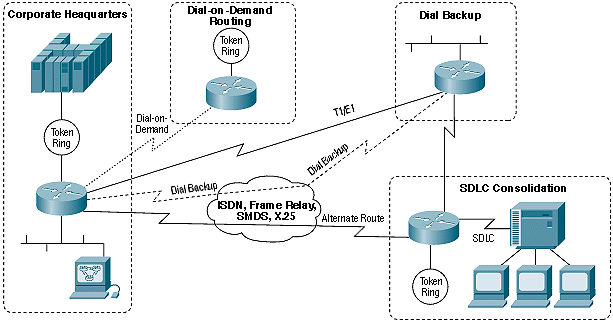
Cisco’s comprehensive WAN support provides organizations with flexibility, scalability, and lower total cost of ownership.
Comprehensive Network Management
As internetworks become increasingly strategic assets, many organizations face the challenging task of how to build a well-managed and productive internetwork that maximizes end-to-end applications availability while it minimizes total cost of ownership. As internetworks expand—often to remote locations—management resources are often limited.
Cisco’s strategy to handle these challenges is threefold: centralization, automation, and integration. This strategy is accomplished with CiscoWorks, a comprehensive package of management applications based on industry-standard platforms and protocols. CiscoWorks offers these services:
-
Configuration services lower the cost to install, upgrade, and reconfigure routers. Further, Cisco’s AutoInstall feature virtually eliminates the time and cost to install remote platforms. With AutoInstall’s plug-and-play features, a remote site simply plugs the router into the network; the central operations center handles the tasks to configure it and bring it online. CiscoWorks also allows you to group routers and apply common configuration changes to all routers at the same scheduled time.
-
Comprehensive monitoring services provide network managers with operational and diagnostic data used to ensure maximum network uptime and applications availability. Through the use of extensive Simple Network Management Protocol (SNMP) Management Information Base (MIB) attributes, network managers can use CiscoWorks show commands to view traffic and error statistics at each interface and for each protocol. Further, debug commands enable fast problem isolation.
-
Diagnostic services help administrators minimize network downtime; for example, there are tools that test router connectivity, trace packet routes, and debug router internal operations.
CiscoWorks runs on NetView/6000 (also known as NetView for AIX), HP OpenView, and SunNet Manager. CiscoWorks also supports a service point interface to NetView to provide central visibility and control. The service point interface ensures that important events can be viewed from a central NetView console and allows applications to be automatically started from NetView, if certain conditions occur. CiscoWorks comes with a set of NetView programs to assist with the management of a Cisco network from NetView.
Cisco platforms also support two-way communication with IBM’s LAN Network Manager. This feature allows network administrators to seamlessly manage their Token Ring LANs from a central site LAN Network Manager, which protects the customer’s investment in training and management applications.
Internetwork Management 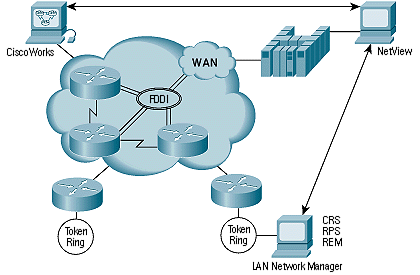
Cisco offers comprehensive management functions that support SNMP, NetView, and IBM’s LAN Network Manager.
Open Standards
Cisco supports an extensive list of Open System Interconnection (OSI), Consultative Committee for International Telegraph and Telephone (CCITT), and Internet Engineering Task Force (IETF) open standards. Where standards do not exist or lack functionality, Cisco has provided the functionality to address key customer requirements.
DLSw
Cisco has supported SNA transport over IP backbones since 1990. A subset of the features that Cisco has offered to support SNA transport are now collectively referred to as Data Link Switching (DLSw). DLSw is also an emerging SNA-over-IP routing specification designed to facilitate the integration of SNA and LAN internetworks, via the encapsulation of nonroutable SNA and NetBIOS protocols within routable IP protocols. The primary goal of DLSw is to provide an open standard that router vendors can use to achieve base-level interoperability among their products. Finally, the DLSw standard includes key recent enhancements over solutions that already exist, including standardized flow control and enhanced management.
Cisco plans to support the DLSw standard in Q1, 1995. Cisco’s DLSw will not only support the standard, it will include additional features, such as extensive media and transport flexibility, and it will add scalability enhancements to allow even larger, integrated networks to support any-to-any connectivity. At the same time as Cisco adds new functionality to the DLSw standard, it will continue to maintain full interoperability and backward compatibility with existing solutions—which will deliver the most robust DLSw implementation in the industry.
Remote Branch Networks Migration
Cisco has developed a comprehensive strategy to migrate branch offices from legacy and SNA networks to integrated client/server and peer-to-peer internetworks. These solutions meet all of the access requirements for remote branch offices: LAN to LAN connectivity, legacy media and protocol support, public network access, and SNA host access.
For LAN media, Cisco offers support for SNA and NetBIOS—on both Token Ring and Ethernet, across all platforms—through SRB/RSRB and Transparent Bridging solutions. In addition, Cisco’s translational bridging addresses Ethernet-to-Token Ring connectivity for these nonroutable protocols. Cisco’s DLSw implementation extends features like local acknowledgment and route caching to Ethernet-based SNA networks, and it enhances the robustness of Token Ring networks.
In branch offices with legacy protocols, Cisco provides a variety of capabilities, including Serial Tunneling of asynchronous, bisynchronous, and SDLC traffic, as well as integrated SDLC-to-LAN conversion. These capabilities consolidate the diverse types of traffic that exist in branch environments. As an example, a typical bank branch can consolidate bisynchronous automatic teller machines, SDLC teller platforms, LAN-based office automation, and asynchronous alarm systems onto a single communication facility.
Cisco’s IBM Access Strategy| LAN Access | Legacy Media | Public Network | SNA Host Architecture |
|---|---|---|---|
| SRB/RSRB Transparent Bridging Translational Bridging DLSw | STUN SDLLC Async Tunnel Bisync Tunnel | Frame Relay - Layer 3 X.25 - Layer 3 QLLC Conversion Frame Relay - Layer 2 (RFC 1490) CFRAD | TN3270 NCIA DSPU Concentration DLUR |
Cisco’s IBM access strategy provides comprehensive support for client/server, SNA, and legacy protocol access through a variety of packet-switching facilities that support various SNA host access options for mission-critical, mainframe-based SNA applications.
Cisco offers many flexible options for connection to public networks. In the Frame Relay domain, Cisco supports two transport options—layer 2 or layer 3. Cisco’s layer 2 choice conforms to RFC 1490 ![]() and allows SNA and NetBIOS to be transported directly over Frame Relay. Customers can also choose to transport at layer 3—which encapsulates SNA and NetBIOS in IP and sends it over Frame Relay—to reap the benefits of IP’s dynamic routing capabilities, such as nondisruptive session reroute. In addition, Cisco provides a cost-effective platform for customers that are migrating from dedicated SDLC networks to Frame Relay, in the form of a Cisco Frame Relay Access Device (CFRAD). The Cisco FRAD can be upgraded to full routing capabilities as LANs are deployed. Cisco’s IBM access strategy supports a variety of SNA host access methods. For SNA users on TCP/IP networks, Cisco has provided TN3270 client services in its access server products. With Cisco’s direct channel attachment to TCP/IP mainframes, TN3270 users benefit from greater levels of performance and scalability. For SNA users on APPN networks, Cisco will offer APPN’s Dependent Logical Unit Requester (DLUR) for 3270 access from legacy controllers and gateways, to avoid costly upgrades to these legacy devices.
and allows SNA and NetBIOS to be transported directly over Frame Relay. Customers can also choose to transport at layer 3—which encapsulates SNA and NetBIOS in IP and sends it over Frame Relay—to reap the benefits of IP’s dynamic routing capabilities, such as nondisruptive session reroute. In addition, Cisco provides a cost-effective platform for customers that are migrating from dedicated SDLC networks to Frame Relay, in the form of a Cisco Frame Relay Access Device (CFRAD). The Cisco FRAD can be upgraded to full routing capabilities as LANs are deployed. Cisco’s IBM access strategy supports a variety of SNA host access methods. For SNA users on TCP/IP networks, Cisco has provided TN3270 client services in its access server products. With Cisco’s direct channel attachment to TCP/IP mainframes, TN3270 users benefit from greater levels of performance and scalability. For SNA users on APPN networks, Cisco will offer APPN’s Dependent Logical Unit Requester (DLUR) for 3270 access from legacy controllers and gateways, to avoid costly upgrades to these legacy devices.
Finally, Cisco’s Native Client Interface Architecture (NCIA) provides customers with a new option for SNA applications access that combines the full functionality of native SNA interfaces at both the host and client with the flexibility to leverage their TCP/IP backbones. NCIA encapsulates SNA traffic within a client PC or workstation, to provide direct TCP/IP access while the native SNA interface at the end-user level is preserved. This can obviate the need for a standalone gateway and provide flexible TCP/IP routing over the backbone with a native SNA interface to the host. Cisco is also offering a Downstream Physical Unit (DSPU) Concentration function that concentrates multiple SNA Physical Units (PUs)—such as clients and cluster controllers—and provides a single PU image to the host. This simplifies host configuration and minimizes WAN overhead.
Cisco’s Native Client Interface Architecture 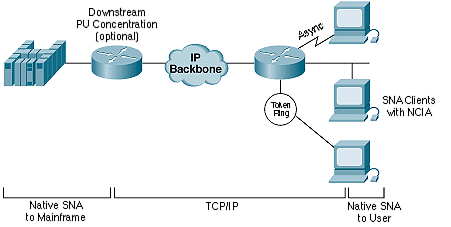
SNA clients with NCIA provide full-function native SNA interfaces to users and provide flexible TCP/IP access to enterprise backbones over any IP media without the requirement of a standalone gateway. Cisco’s platform provides efficient native SNA interface to mainframes.
Mainframe Integration
A router is an excellent vehicle to use to integrate the mainframe, because mainframe customers already use routers in conjunction with LAN channel controllers. The advantage of a direct attachment to a mainframe channel is greater performance and better integration with fewer points of failure. With the use of the Cisco 7000 platform, Cisco’s strategy is to combine the power of the media-speed mainframe interface with media-speed LAN, WAN, and ATM interfaces and Cisco’s 270 kpps silicon switching engine, to offer the industry’s most powerful mainframe and LAN integration solution.
Cisco’s Channel Interface Processor (CIP) supports both Enterprise Systems Connection (ESCON)—IBM’s high-speed channel architecture, first introduced in 1990—and Bus and Tag connections—IBM’s older channel architecture, widely used in the current installed base of mainframes.
The Cisco 7000 CIP includes a powerful onboard protocol processing engine to ensure that no bottlenecks are created. In addition, the Cisco 7000 offers dual power supplies and hot-plugable interface cards to ensure high availability. Across all of Cisco’s platforms, Cisco IOS software offers dynamic reconfiguration of any configuration option, which further improve availability because it minimizes the need for scheduled downtime. With the 7000’s high-density LAN and WAN cards, FDDI, and ATM interface modules, it is the premier mainframe channel integration platform.
Mainframe Integration 
Cisco’s direct channel attachment allows users to tightly integrate mainframes, both with today’s networks and those of the future.
APPN Network Node-Based Internetwork
Cisco is committed to supporting IBM’s advanced peer-to-peer networking. Cisco will provide native APPN Network Node support in its internetworking platforms and has licensed IBM source code to ensure 100 percent network node compatibility. Cisco products, with their extensive support of LAN and WAN media, provide an ideal, high-performance platform to support IBM’s APPN NN. Cisco products with NN functionality can be used in a pure APPN network with a mix of other vendors’ APPN platforms. Alternatively, Cisco’s APPN platform can be used in integrated multiprotocol internetworks, with Cisco’s prioritization techniques providing a means to control bandwidth allocation. Cisco will also provide a cost-effective method to allow 3270 legacy traffic to take advantage of APPN: the DLUR function. With the use of this capability, multiple controllers or SNA gateways that support legacy SNA can attach to a Cisco platform, and legacy traffic can be transported across a native APPN backbone without the need for upgrades to APPN.
Cisco will also support APPN’s High Performance Routing (HPR) protocol, which will enable native SNA to nondisruptively recover from link failures and which will improve APPN performance.
Cisco products allow customers to integrate legacy SNA networks today and choose from a variety of options for future migration: TCP/IP based, APPN-based, or mixed TCP/IP and APPN.
Cisco’s APPN Solution 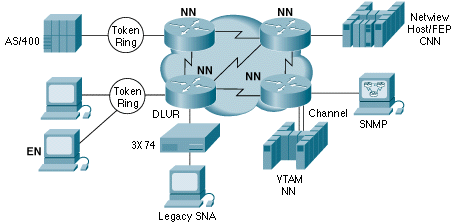
Cisco’s APPN implementation supports both today’s legacy applications and future peer-to-peer applications while it guarantees 100 percent compatibility with APPN end solutions.
IBM Collaboration
Cisco and IBM are collaborating on many fronts to enhance product capability, customer service, and manageability and to protect customers’ investments in computing and networking facilities. The two companies cooperated to develop the four-port Token Ring card with the IBM “Spyglass” chipset, which offers the highest performance in the market. Cisco has also licensed ESCON and Bus and Tag technologies from IBM for incorporation into the Cisco 7000 CIP. Additionally, Cisco uses IBM test facilities to ensure compatibility between the Cisco channel interface and IBM mainframes.
Cisco and IBM also work closely together as part of the APPN Implementors’ Workshop (AIW), which is an IBM body developed to define APPN protocols. Cisco licenses the APPN source code from IBM. The two companies also cooperatively established the Data Link Switching Working Group within the AIW, to help promote the development of the DLSw standard.
For service, IBM’s field service organization performs on-site maintenance, stocks and delivers spare parts, and provides installation services for Cisco customers. Cisco is also actively collaborating with IBM to enable interoperability with LAN Network Manager agents on IBM’s Token Ring network management platform. In addition, Cisco is a member of the NetView/6000 Association, which incorporates the Cisco MIB into NetView/6000 and certifies compatibility. Finally, Cisco is providing CiscoWorks applications for NetView/6000, as well as compatibility certification.
Working with IBM 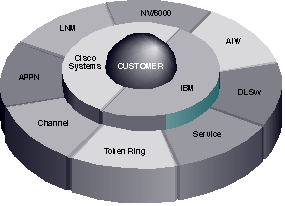
Cisco has many cooperative relationships with IBM, to enhance product compatibility, customer service, and manageability.
The Future: Beyond Integration
As customers implement Cisco technology and integrate their SNA environments into multiprotocol internetworks, new options become available. Whatever direction the customer chooses—whether to evolve from SNA to APPN, from SNA to client/server, or to maintain a pure SNA environment—Cisco will provide the most flexible migration paths to future networks.
At the heart of Cisco’s efforts is its industry-leading Internetwork Operating System that integrates all environments: IBM-oriented access, core backbone, mainframe integration, and workgroup technologies. Cisco’s years of experience with internetworking all major protocols and environments across every type of WAN service, combined with the company’s dedication to the IBM environment, make Cisco the premier internetworking vendor for IBM SNA and mainframe integration both today and tomorrow.
Integrated Internetworking with IOS 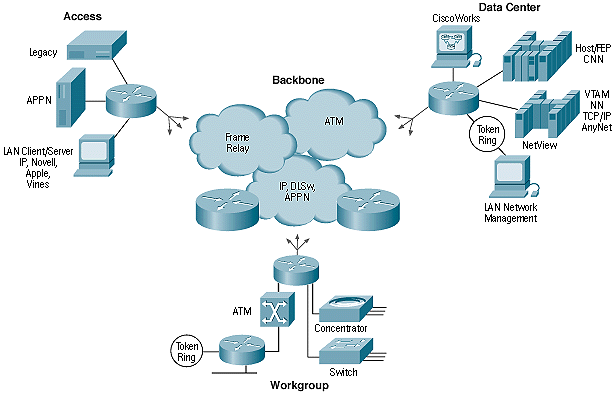
Cisco’s comprehensive IBM internetworking strategy provides the most flexible migration options in all areas of future internetworks; Access, Workgroup, Backbone, and Data Center.
 Feedback
Feedback